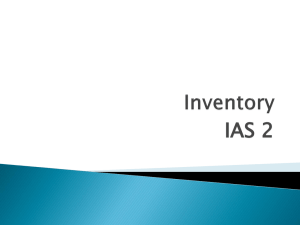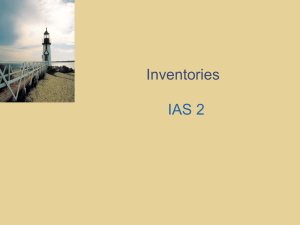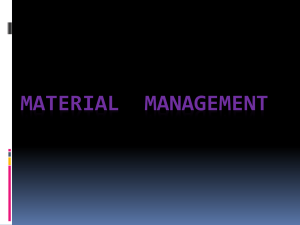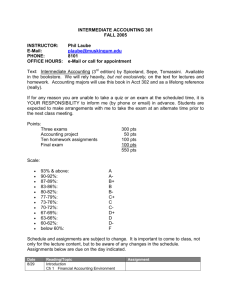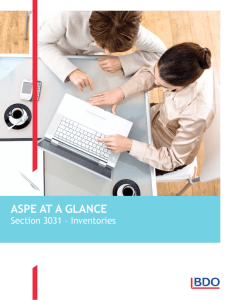Accounting for Leases (AS 19)
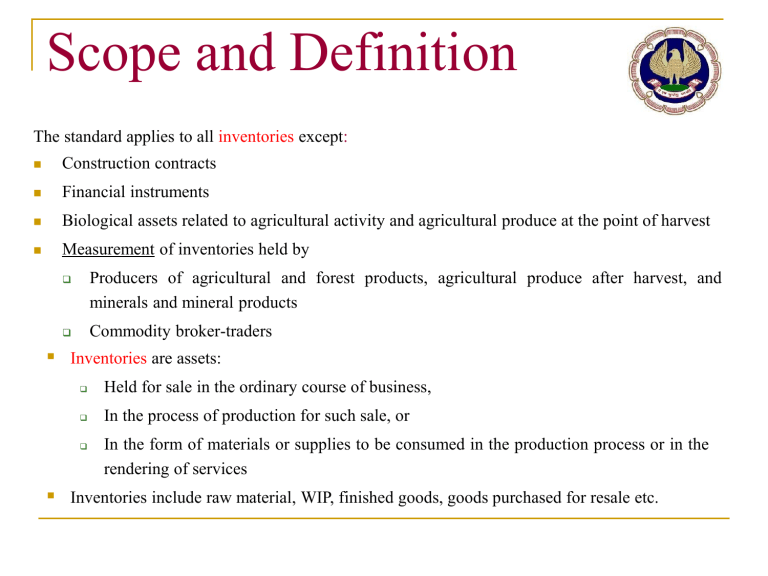
Scope and Definition
The standard applies to all inventories except :
Construction contracts
Financial instruments
Biological assets related to agricultural activity and agricultural produce at the point of harvest
Measurement of inventories held by
Producers of agricultural and forest products, agricultural produce after harvest, and minerals and mineral products
Commodity broker-traders
Inventories are assets:
Held for sale in the ordinary course of business,
In the process of production for such sale, or
In the form of materials or supplies to be consumed in the production process or in the rendering of services
Inventories include raw material, WIP, finished goods, goods purchased for resale etc.
Measurement
Inventory is measured at the lower of
Cost
Includes all:
Costs of purchase
Costs of conversion
Other costs incurred in bringing the inventories to their present location and condition
(Refer next slide)
Net realisable value (NRV)
Estimated selling price in the ordinary course of business
Less: estimated costs of completion and costs to make sale
Assets should not be carried in excess of amounts expected to be realised from sale/use
NRV is based on most reliable evidence at the time of estimation regarding amounts expected to be realised
Inventories are usually written down on an item by item basis*
Consider the purpose for which they are held*
(*Refer slide XX)
Cost
Purchase cost includes:
Purchase price
Duties and other taxes
Freight inwards
Other expenditure directly attributable to the acquisition
VAT/CENVAT/Excise duty/Customs duty only if not subsequently recoverable
Excludes:
Trade discounts
Rebates
Duty drawbacks
Cost of conversion includes:
Direct material, labour, other direct costs related to production
Overheads (fixed and variable production overheads)
Absorption costing - absorb as per normal capacity
Other costs include interest and borrowing costs only in exceptional cases but not those for inventory routinely manufactured or otherwise produced in large quantities on a repetitive basis over a short period
Excludes:
abnormal amounts of wasted material, labour or other production costs
storage costs, unless necessary in the production process prior to a further production stage
administrative overheads that do not contribute to bringing inventory to its present location & condition
selling and distribution costs
Joint products and by-products
Where cost of conversion is not separately identifiable
allocation on rational and consistent basis
e.g., relative sales value of each product either
at the stage when the products become separately identifiable or
at completion of production
If by-products, scrap and waste materials are immaterial
value is measured at NRV and
value is deducted from the cost of main product
Normal capacity
Average production over a number of periods / seasons
under normal circumstances
taking into account loss of capacity from planned maintenance
Actual level may be used if it approximates normal capacity
Abnormally high production
fixed production overheads allocated to each unit of production is decreased so that inventories are not measured above cost
variable production overheads are assigned to each unit of production on the basis of the actual use of the production facilities
Net Realisable Value (NRV)
Inventories are usually written down on an item by item basis
Sometimes appropriate to group related or similar items
They relate to same product line that have similar end use and produced/marketed in same geographical area and cannot be practicably evaluated separately
Should not be based on a broad classification of inventories e.g. finished goods or business segment
Estimates of NRV also take into consideration the purpose for which the inventory is held
Quantities held to satisfy firm sales or service contracts
Quantity covered by contract: NRV is based on contract price
For excess quantities: NRV is based on general selling prices
Materials/other supplies held for use in production:
Written down to NRV only if
- There is a decline in the price of materials AND
- Cost of finished products is expected to exceed NRV
Replacement cost may be the best available measure of NRV
Cost Formulae
Specific identification of items of inventory
Not ordinarily interchangeable
Segregated for specific project
Identified actual costs
Other items of inventory, apply either
first-in, first-out = FIFO
weighted average
Fairest approximation to present location and condition
FIFO: inventories purchased/produced first are sold first
inventory is valued at costs of units most recently purchased/produced
Weighted average method requires inventory to reflect weighted average cost based on unit cost of both:
units on hand at the beginning of the period, and
units purchased (manufactured) during the period
Cost Measurement Techniques
Measurement Techniques
Measurement techniques include
retail method
standard cost
These techniques may be used for convenience if the results approximate cost
Consistency: Different Cost Formulae for Inventories
Same cost formula for all should be used for inventories of similar nature and use
Different cost formula may be justified for inventories with different nature and use
Apply treatment consistently once chosen
Recognition as Expense
When inventories are sold -
Recognise carrying amount as an expense in the period in which the related revenue is recognised
Matching of costs and revenue
When inventories are written down to NRV
Recognise all losses of inventories as an expense in the period in which they occur
Recognise reversals of write-downs as a reduction in the amount of inventories recognised as expense in the period in which reversal occurs
Disclosure
Accounting policies for measuring inventories Including cost formulas used
Carrying amounts of inventories, including classifications and inventories carried at fair value less costs to sell
Amount of inventories recognised as an expense
Write-down and reversals Recognised as expense and as reduction of expense respectively
Circumstances or events that led to a reversal
Carrying amount of inventories pledged
